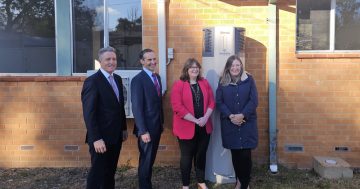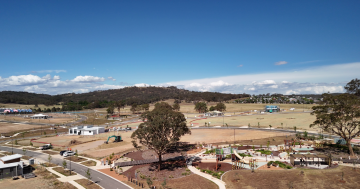
Ginninderry Project Director Stephen Harding, Federal Housing Minister Julie Collins, CHC CEO Andrew Hannan and ACT Housing Minister Yvette Berry at the announcement of the Build-to-Rent-to-Buy pilot program. Photo: Claire Fenwicke.
The shift is on to boost the number of rental properties in the ACT’s tight and expensive market, with funding in next week’s Budget for five Build-to-Rent sites, including a “large-scale” one in the Gungahlin Town Centre.
The Build-to-Rent focus includes a significant expansion of community housing and comes as fewer people can afford to buy their own home and many essential workers are struggling in the tough rental market.
It is part of what the ACT Government says is a record housing spend of $345 million in the 2023-24 ACT Budget, the bulk of which will go to the public housing portfolio.
$56 million will go towards building 140 public housing dwellings, part of the government’s eight-year renewal program, while $177 million has been set aside for Housing ACT operations, home repairs and maintenance.
The site for the Gungahlin BTR project is still being investigated, but the development is likely to be a multi-unit development along the lines of the release by tender of a 7000 sqm block in Turner on Northbourne Avenue.
The Turner site has a minimum dwelling requirement of 270 units, with at least 15 per cent required to be affordable rentals to eligible tenants.
The government is flagging that more sites will be released in coming years under its BTR approach, which offers certain incentives to developers.
The other BTR sites will be delivered via a new $60 million Affordable Housing Project Fund, including three via community housing providers and one through a $4.5 million grant to the previously announced Ginninderry Womens Housing Initiative, a Build-to-Rent-to-Buy pilot program.
Details of the community housing projects are yet to be revealed, but they are expected to provide 160 affordable rentals to low-income tenants for a minimum of 15 years.
The Ginninderry project will deliver up to 22 affordable rental dwellings to low-income women in Strathnairn, who will have the opportunity to eventually own the properties.
The government is inviting community housing providers and BTR operators to submit shovel-ready proposals for financial support through Affordable Housing Project Fund.
The government is also offering to allow developers to convert their commitments to affordable homes for purchase to affordable rentals, whereby they must hold on to the properties for a minimum of 10 years.
The Budget will also allocate $11 million to “accelerate” the government’s land release program, saying a mix of greenfield and infill sites with capacity for 16,000 dwellings will be released over five years.
But it is unclear if this means more land will actually be released than already scheduled, although the government says that in combination with its planning reform program, it wants the private market to deliver as much new housing as possible to meet the demands of a city expected to grow to half a million residents by 2027.
With this Budget, the government will be releasing multi-unit development sites to market in 2023-24 with requirements for more than 200 affordable, community and public housing dwellings.
The government is also factoring in a certain amount of private land release, mainly in established areas.
ACT Chief Minister Andrew Barr said the government was increasing housing stock across the board with a range of initiatives designed to increase choice, access and affordability.
“This year’s ACT Budget includes a range of measures to ensure Canberra has the right mix of housing to meet the needs of our growing population,” he said. “This includes a particular focus on increasing the supply of affordable rental properties across the Territory.”
Mr Barr said the government would also continue to cut stamp duty as it had in every Budget since 2012 as part of its tax reform agenda, removing a significant barrier to home ownership in the ACT.
“Housing affordability is a national issue requiring broad reform and the ACT will continue to work collaboratively with the Commonwealth Government to deliver our commitments under the National Housing Accord,” he said.
The ACT will also receive $50 million from the Commonwealth in the coming weeks to build more social housing, which the government will have until 30 June 2025 to spend.
Original Article published by Ian Bushnell on Riotact.







